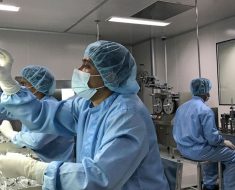
- While many people survive cancer, older people often experience bone fracture injuries later.
- A new study finds that, especially in the first five years after an advanced cancer diagnosis, there is an increased chance of bone fractures for older patients.
- The most likely injuries are vertebral fractures and hip fractures.
There are an estimated 18.1 million cancer survivors currently in the United States. Due to the country’s growing and aging population, there may be 26.1 million survivors by 2024. Of these, 73% will be older than 65.
For the elderly, however, completing cancer treatment may not mean the end of related medical challenges. Frailty-related bone injuries, for example, are common among survivors. A new cohort-based study from the American Cancer Society—involving 92,431 older adults whose average age was 69.4 years—investigates how often such injuries may occur.
The new study has found that older cancer survivors are more likely to experience a bone fracture for several years after diagnosis than people who have not had cancer, particularly this risk is 57% higher within the first year of diagnosis.
Older cancer survivors who were diagnosed with advanced-stage cancer 1 to 5 years earlier also had a 112% higher risk of fracture than participants without a history of cancer.
“This is one of the first studies to investigate the associations among cancer diagnoses, including time since diagnosis and stage at diagnosis, health behaviors, and treatment with the risk of bone fractures,” Dr. Erika Rees-Punia told Medical News Today.
Dr. Rees-Punia is the senior principal scientist of epidemiology and behavioral research at the American Cancer Society, and the study’s lead investigator.
The study is published in the Journal of the American Medical Association (JAMA) Oncology.
Which bones are more at risk?
“Prior studies on cancer and bone fractures largely focus on breast cancer survivors. We were able to include survivors of several cancer types in our study,” said Dr. Rees-Punia.
“Prior studies generally focus on one fracture site (largely hip) or combine all bone fracture sites together. We were able to examine the risk of fracture by site for pelvic, vertebral, and wrist fractures,” she pointed out.
The researchers also found the increased likelihood of injury was greatest for vertebral and pelvic fractures, as opposed to radial fractures.
Dr. Anna L. Schwartz, author and researcher specializing in the beneficial effects of exercise for cancer survivors, who was not involved in the study, pointed out to MNT:
“The finding that older adult cancer survivors are at increased risk of fracture for a prolonged time after treatment ends speaks to the critical need for exercise oncology rehabilitation to restore balance and strength to reduce the risk of falls.”
Dangers of bone fractures in older people
Dr. Schwartz explained that bone fractures can lead to rapid debilitation in health in both older adults and older cancer survivors and that it may often be “difficult to fully recover from.”
“These fractures, specifically hip and spine, lead to decreased functional ability, loss of independence, pain, suffering, high use of medical care, and cost/burden (morbidity and mortality) to society,” she told MNT.
“[Older cancer survivors] often have chemotherapy-induced peripheral neuropathy of their feet, which affects their balance and ability to stand and walk. This combined with decreased physical function predisposes them to a fall that could be straight down, fracturing their pelvis or falling backward, causing a vertebral fracture.”
— Dr. Anna L. Schwartz
Dr. Schwartz said that bone loss is expected to happen naturally as one ages but that many medications used to treat cancer such as doxorubicin, cyclophosphamide, anastrazole, letrazole, leuprolide, goserelin may accelerate this process.
“In addition, many older adults have co-morbidities and take medications that impair bone healing (e.g., NSAIDS),” she added.
Dr. Schwartz further explained the possible mechanisms behind why older adults are prone to bone fractures:
“Multiple factors affect delayed bone healing in elderly cancer survivors and the elderly in general. These factors include age-related changes in the inflammatory response, impaired angiogenesis, poor vascularization, a decreased quantity and quality of osteochondral stem cells.”
Effects of chemotherapy, smoking
The study also found that having had chemotherapy or being a current smoker increased one’s likelihood of bone fractures as well.
“Cancer survivors may be at a higher risk of bone fractures because of higher rates of osteoporosis coupled with low muscle mass, and potentially also because of balance issues and unexpected changes in gait associated with chemotherapy,” said Dr. Rees-Punia.
“Unfortunately, we were not able to study the role of different types of chemotherapy on the risk of bone fractures.”
“Bone that is lost during chemotherapy does not recover to its original state because bone remodeling is a slow process. Resistance exercise (e.g., weightlifting) can increase bone density, but the changes are small, and it takes about a year to see measurable change on a DEXA scan.”
— Dr. Erika Rees-Punia
“The finding that older cancer survivors who are currently smoking are at a higher risk for fracture is a new finding, and one that may be helpful to motivate cancer survivors (hopefully of all ages) to quit smoking. Further cancer exercise research is needed for fracture prevention trials among older cancer survivors,” Dr. Schwartz said.
“These findings are from a large cohort study and not from a prospective randomized control study, but it is reasonable to recommend that older adults with a history of who currently smoke stop smoking to potentially reduce their risks for fractures and of course improve cardiopulmonary health,” she added.
Vertebral and pelvic fractures
Dr. Rees-Punia said that they observed some site-specific differences in fracture risks but that the mechanisms were unclear.
“It is possible that the older cancer survivors included in this study were risk-adverse and thus not engaged in activities that may elicit a forward fall contributing to a radial fracture,” she said.
“For example, hip fractures tend to occur in adults who are older, very physically inactive, and are more likely to fall (95% of hip fractures are caused by falling), while radial fractures are more likely to occur among more active, relatively healthy adults who walk more and participate in a wider range of activities,” she elaborated.
How to prevent bone fractures
Dr. Rees-Punia said she hoped the study results help guide clinicians and cancer patients around how to avoid bone fractures.
“Fracture prevention programs for survivors could include smoking cessation programs and referrals for physical activity with cancer exercise professionals,” she said.
“Clearly, clinical recommendations for fall prevention are indicated in this group of frail elderly. This study provides further support for moderate-to-vigorous physical activity and strength training to reduce the risk of fracture after a cancer diagnosis.”
— Dr. Anna L. Schwartz
Dr. Schwartz advised that, for safety, “Older adult cancer survivors should be triaged to an appropriate exercise oncology program that meets their individual needs, be that in a supervised rehabilitation setting — e.g., with a psychiatrist or PT [physical therapist] — or a community-based setting (with a cancer exercise trainer).”
Source: Read Full Article





